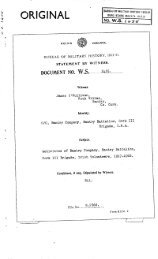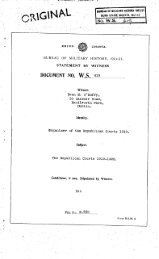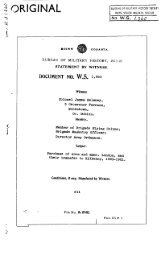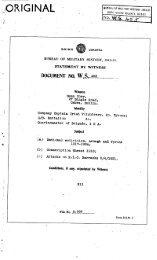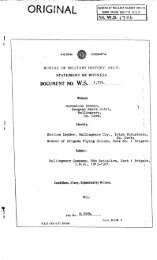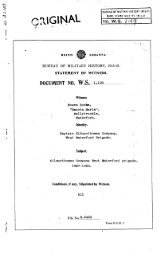ROINN COSANTA. BUREAU OF MILITARY HISTORY, 1913-21 ...
ROINN COSANTA. BUREAU OF MILITARY HISTORY, 1913-21 ...
ROINN COSANTA. BUREAU OF MILITARY HISTORY, 1913-21 ...
Create successful ePaper yourself
Turn your PDF publications into a flip-book with our unique Google optimized e-Paper software.
<strong>ROINN</strong><strong>COSANTA</strong>.<strong>BUREAU</strong> <strong>OF</strong> <strong>MILITARY</strong> <strong>HISTORY</strong>, <strong>1913</strong>-<strong>21</strong>.STATEMENT BY WITNESS.DOCUMENTNO.W.S.1,003WitnessPatrick Ahern,1 McDonagh Terrace,Fermoy,Co. Cork.Identity.Second Lieut. Fermoy Coy. Irish Vol's. 1917 -;I.0. Fermoy Battalion Cork II Brigade.Subject.Irish Volunteers, Fermoy, Co. Cork,1917-19<strong>21</strong>.Conditions, if any, Stipulated by Witness.NilFile No.S.2310Form B.S.M.2
STATEMENT BY PATRICK AHERN,McDonagh Terrace, Fermoy.I was born in Fermoy on February 26th 1899.My grandparents on both my father's and mother'sside were farmers. They were evicted from their holdingson the Buckley and Montgomery Estates by the landlordsbecause they awed one half year's rent. The rent duewas actually tendered to the agent but was refused as theWhole idea behind the eviction was to banish the smallholders. and turn the district into one large estate.There was a company of the Irish Volunteers inFermoy before Easter Week 1916 but I was not a member.As far a I can remember the pioneer in the organisationof this company was Seán O'Brien who was; a native ofFermoy. He was a gardenerS at the Presentation Convent.Other members were Jimmy Barry, Pad Fleming, Dick Bulman,Bill and Mick O'Connell, Dan Fitzpatrick and Mick Fitzgibbon.I joined the Volunteers in the Sinn Féin Hall inchapel Square, Fermoy, about April or May 1917. There.were about 60 Volunteers in the company when I joinedand the officers as far as; I can remember were:0/C Liam Denn1st Lt. Liam Lynch2nd Lt. Lar. CondonAdjt. Geo. PowerQ/M Mick Fitzgerald.
2.The only drill carried out in the early stages wassimple. Foot-drill, parades and drills were held mainlyin the fields in the vicinity of the town and sometimesin the Skin Fêin Hall. Most of the drill instruction wascarried out by the officers of the company who took thevarious sections. in turn. At this time it was not tooeasy to get into the Volunteers. New recruits were usuallyaccepted only on the recommendation of other membersand all proposals for membership were usually vetted bytheofficersShortly after joining the Volunteers I remembertaking part with the other members of the Company andmembers of the public in a torchlight procession to celebratethe success of Joe McGuinness in the Longford Election inMay 1917. The parade was in charge of Liam Lynch.It marched up Barrack Hill which at the time was called"Eittle England". On the way up the parade and processionwas sub jected to much barracking by the Separation women(British soldiers' wives) but on the way back it wasattacked by the women as well as by soldiers who wereon the street. It developed into a general free-for-allbut Liam Lynch ordered the parade to "stand fast andreform ranks". The company then moved back to the Squarewhere the parade was dismissed. This incident is quotedto give an idea. of. the outlook and mentality of themajority of the people of Fermoy at this time.Sometime in October 1917 the Company Captain (LiamDenn) was arrested for illegal drilling. He was sentencedto a term of imprisonment in Cork gaol. His arrest wasfollowed at. few weeks later by that of Lar Condon (2nd Lt.)
3.on a similar charge. He was also sentenced to a termof imprisonment. With a number of other prisoners thetwo went on hunger-strike and they were released someshort time. before Xmas 1917. Following the arrest ofLar Condon there was a change of officers. The newofficers of the company were:0/C Liam Lynch1st Lt. Mick Fitzgerald2nd Lt. John Fanning.At this time I was despatch rider for the area andmy routa covered Glanworth (Paddy Barry 0/C), Kilworth(Tom Joyce 0/C), Araglin (ton Leddy 0/C) and Fermoy(LiamLynch).Early in 1918 the Fermoy Battalion was formed asthe Volunteer organisation was growing in strength inthe surrounding area. The Battalion was attached tocorkBrigadewhich at this time consisted. of somethinglike twenty battalions. The battalion was made up of thefollowing companies (10): Fermoy, Glenville, Watergrasshill,Rathcormac, Bal1ynoe, Bartlemy, Castlelyons, Kilworth,Araglin and Conna.The Officers of the Fermoy Battalion were:0/C Martin O'Keeffe, Ballynoe.Vice 0/C Lar Condon, Fermoy.Adjt. Liam Lynch, do.Q/M. Mick Fitzgerald, do.As Liam Lynch and Mick Fitzgerald were now on theBattalion Staff it was necessary to elect a new Company 0/Cand 2nd Lieut. The Fermoy Company officers now were:
0/C John Fanning.1st Lt. "pa" Gallagher2nd Lt. Mick Sweeney.The strength of the company began to increase steadilyabout this time and before the conscription scare hadreached a strength of about 120 which remained constantto the Truce, Of course during the spring and summer of1918 while conscription was threatened there was a largeinflux of new recruits; but they all faded away again whenthe threat of conscription had passed.Liam Tobin who was on General Headquarters staffarrived in the area during the early part of 1918and was in constant touch with the Volunteer units in thearea. I think that he was acting more or less asorganiser. I know that he was also one of the partyengaged in an attempt to capture arms by holding up atrain at Castletownroche early in May 1918.As far as I can recollect Liam Lynch receivedinformation from a contact of his in the Army Stores atCobh (Queenstown then) that a large consignment of riflesand ammunition was being dispatched to Fermoy on a datein early May 1918. Arrangements were made by theBattalion Officers in conjunction with John Fanning (0/CFermoy Company) to hold up the train with a. view tocapturing this lot of enemy stores. With a number ofother members of the Fermoy Company including Tim Fenton,Jack Herlihy, Jack Fitzgerald and Patk. ("Powder")Moloney, I proceeded to a pre-arranged meeting place atRenny boreen - about 6 miles from Fermoy on the roadto Castletownroche where I met the following who had
5.already arrived by car: Liam Lynch, Liam Tobin, LarCondon, Jack O'Neill, Mick Fitzgerald, John Fanning(Company 0/c), George Power, as well as three railwaymenwho were to co-operate (Jerh. Corkery, Tom Egan and TimSheehan). In addition to the above named there werealso selected members of the local companies who wereengaged on scouting and outpost duty as well as standingby at Renny boreen to transfer the captured material tothecars.Incidentally the cars, which had been hired to goto a funeral, were driven by Tom Cavanagh (later BattalionI/O) and Mick McCarthy. One carload (Tom Egan, TimSheehan, Jerh. Corkery, Jack 01eill and John Fanning)proceeded to the vicinity of Castletownroche RailwayStation to await the arrival of the train while two others(Liam Denn and Ted Heskin) were already on the: platform.The latter pair were to board the footplate as the enginewas about to pull out and to compel the driver to halt thetrain at Renny boreen where the main party were. Theothers in the vicinity of the station were to board thetrain also while the railwaymen (Tom Egan, Jerh. Corkeryand Tim Sheehan) were to be prepared to take over the trainin an emergency. However, due to an error in timingon the part of the Volunteer who had been delegated tocut the wires the operation did not proceed according toplan. It had been agreed that the wires would not becut until the train had whistled to show that it was aboutto leave the station but it was later established that thewires were in fact cut as the train whistled when aboutto enter the station. As a result the train did notleave the station at all as in the absence of telephonecommunication with the next station on the line -
6.Ballyhooley - it was not allowed to proceed. At thisstage it was too late to alter the plans and the job wascalled off. We then returned to our homa area, as didall the others mobilised for the job.Several raids for arms were carried out in thearea about this time and the following stock of arms wasaccumulated by the company: 7/8 rifles, 3O shotguns andabout half dozen 22 rifles as well as a quantity ofammunition. in addition to these raids on private housesa considerable quantity of explosives, shotgun cartridges,detonators and fuse was obtained in a raid on Barry'shardware and firearms premises at the Timber Yard, Fermoy.Nearly all the latter material as well as the capturedarms were dumped in Clondulane. These operations werecarried out under John Fanning 0/C and witness (Patk.Ahern), while practically all available members of thecompany took part.I should mention that in only one ease was thereany opposition shown to the surrender of the arms. Thiswas at the house of D.L. O'Gorman, Janeville, Fermoy,where the houseowner fired on the raiding party and drovethem off. Subsequently witness (Patk. Aherh) with JohnFanning, "Pan" Gallagher and Tim Sheehan raided the houseon a Sunday morning when the owner was away at Massand obtained the guns. in this connection I would liketo state that I was well known to Miss Q'Gorman, who waspresent on the occasion of the raid, but apparently shedid not disclose the identity of the raiders to herfather when he returned home.Since I joined the: Volunteers in 1917 1 wasactively associated at all times with the political wing
7.of the movement - Sinn Fêin. Practically all Volunteersas well as their families were members of Sinn Fêinand helped in every possible way in the organisation of thatbody. During the by-election in Waterford in March 1918I travelled to Waterford City with a large party ofVolunteers from Fermoy and the surrounding districts.We were engaged in patrolling the streets in an endeavourto protect the Republican supporters from the attacks ofthe Redmondite and British Army element who ware violentlyopposed to Sinn Fêin. The atmosphere in Waterford Cityabout this time was somewhat similar to that in our homearea(Fermoy- another garrison town).It was now January 1919 and on January 6th Cork 11Brigade was formed. The officers of the new brigade were:0/C Liam Lynch FermoyVice O/C Dan Hegarty MallowAdj. Tom Barry GlanworthQ/M Geo. Power Fermoy.which now was:This led to further changes in Fermoy Battalion StaffO/C Mick Fitzgerald FesmoyVice 0/C Lar. Condon do.Adj. Moss Twomey do.Q/M Con Leddy Araglin.Drilling and parades continued as usual about thistime but Volunteers were, in general, becoming moremilitary minded. The general subject of conversationwhen Volunteers met mainly concerned the best method ofobtaining arms. Naturally in Fermoy where we were in thecentre of a large enemy concentration our minds were
8.continually concerned with this. problem. Consignments ofmilitary stores were regularly handled at Fermoy stationso it was arranged that Jerh. Corkery and Torn Egan (twoshunters employed at the station) would arrange to shunt awagon containing stores "down the 1ine" one night in thelate spring of 1919. The wagon contained some thousandsof rounds of .303 rifle ammunition made up in slings incardboard boxes. The wagon was opened by John Fanning(Company 0/C) and witness (Patk. Ahern) and the contentswere removed by members of the Clondulane Section of theFerrnoy Company to a dump in their own area. This dumpwas situated in Clondulane Mills. it was made byconstructing a false bottom in a large wheat bin whichwas not in use. This bin was between 50 and 60 feetdeep and the bottom was reached by means of a permanentladder affixed to the inside of the bin. To ascertainwhether there was anything in the bin it was necessaryto go down the ladder and to take with you an inspectionlamp lighted by electricity. As there was always oneor two bins In the mill which appeared to be empty at onetime or another there was never any suspicion that thebin in question was being used as a dump. This dumpwhich wasconstructed by Mick Fitzgerald, who later died on hungerstrikein Cork Gaol, was never discovered. The ammunitioncaptured on this occasion supplied the Brigade andBattalion Columns of Cork 11 Brigade during the subsequentperiod of intense activity during late 1920 and 19<strong>21</strong>.Araglin R.I.C. barracks was captured towards theend of April 1919 but as far as I know Mick Fitzgerald(Battalion 0/C) was the only participant in thisengagement outside of the members of the Araglin Company.It was purely a local Job
9.The usual drill and activities continued untilearly September 1919 when the raid on the church partyof the Shropshire Light Infantry took place at theWesleyan Church on Sunday morning September 7th 1919.This was one of a number of small parties of militarywhich used to parade to the churches of the variousdenominations in the town on each Sunday morning. Thestrength of the party was usually about twenty and marchedto the Wesleyan Church at Walkers Row. The party aswell as all the others on church parade always carriedrifles.The Brigade 0/C (Liam Lynch) decided to examinethe possibility of capturing the rifles carried by theWesleyan Church party. Several meetings were held atwhich officers of the Fermoy company as well as some othercompanies of the battalion were present. Fermoy Companywere made responsible for the preliminary scouting workand regular reports were furnished to the officers whowere planning the operation. The final meeting whichwas held on Friday night (September 5th 1919) was attendedby Liam Lynch, Lar Condon, John Fanning (Company 0/C),"Moss" Twomey, Paddy Ahern (witness), George Power (allFermoy),Tom Griffin (Ballynoe) and Con Leddy (Araglin).The movements of the Wesleyan Church party werekept under observation for about three months. The partyusually marched in fours from their barracks via BarrackHill,theSquare and Patrick St. to Walkers Row - thesite of the Wesleyan Church. The rifles were carriedat the slope until the party were within a short distanceof the church when the arms were changed to "the trail".
10.The Brigade 0/C through his contact in Army Storesat Cobh (Paddy Hackett) ascertained that the rifles wereprobably loaded as instructions had been issued that theChurch parties should carry loaded firearms. This changein the normal procedure had, it was stated, been madebecause of an effort to disarm a soldier in Castletownberearea.Every possible aspect of the movements of theparticular enemy party was covered in the preliminaryinvestigation. it was decided to ascertain whether, whenthe military party entered the Church, they stacked theirrifles inside the door, or took them into the seats withthem. This latter investigation was also allocated to meand after spending a few Sundays in the vicinity of theWesleyan Church I established that the rifles were takeninto the seats.When all the reports from the various observershad been examined Liam Lynch decided to attempt tooverpower the party just as it reached the Wesleyan Churchand about the time the order was given to "trail arms".Arrangements were also made to obtain transport.from the Mallow Battalion arid from the neighbouringWaterford Brigade as well as from Rathcormac in FermoyBattalion. The Mallow car, which was a Buick car drivenby Leo O'Callaghan, Mallow, carried in addition DanHegarty (Brigade Vice 0/C), Owen Harold (O/C Mallow Company),Ned Waters and Bryan Kelly. The Ratbcormac car was drivenby Jack Mulvey but the car from Waterford Brigade whichtook Geo. Lemon (Bde. Vice 0/C) and Mick Mansfield (Q.M.)to the vicinity did not report to the rendezvous. Itappears that when the driver learned of the intended job
11.he refused to proceed to Fermoy. I do not know whetherGeo. Lennon and Mick Mansfield took part in the engagement.The Mallow car and party were picked up at thelimekiln on the Castlehyde road by witness (Paddy Ahern)who piloted them to the meeting place at the rere of theFermoy Hospital. I remember the Brigade Vice 0/C (DanHegarty) who was in this car saying at the time "If Lynchcarries this off I'll take off my hat to him". TheWaterford car was to have been met by Mick Fitzgeraldwhile the Rathcormac car did not require a pilot as thedriver knew the area well.Several men from the Ballynoe and Araglin Companiesin addition to the Mallow and Fermoy men already mentionedwere engaged in various activities in connection with thisjob. Some were strolling round - reading papers andgenerally appearing to be killing time - in the vicinityof the route taken by the Church party as they neared theWesleyan Church. All had instructions to rush the enemyparty when the order "hands up" was given by Lar Condonwho was in charge of the maim attacking partycomposed of Mick Fitzgerald, Lar Condon, Jack Fitzgerald,John Earning and witness (Paddy Ahern). The order"hands up" was to be given just following the order to themilitary party to "trail arms".Liam Lynch was with the Mallow party in their car,which was parked east of the Wesleyan Church and behindwhich was the Rathcormac car driven by Jack Mulvey.As the enemy party approached the Wesleyan Church theMallow car with its passengers, driven by Leo 0'Callaghan,moved slowly towards it. It reached the end of theparty on Church parade just as the order "hands up" was
12.given by the 0/C. main attacking party. The driver swunghis car across the road behind the military party thuscutting off their line of retreat while the occupants ofhis car jumped on the soldiers. The engagement was allover in less than five minutes and the rifles were loadedinto the two cars.The main attacking party, of which I was a member,were ambling along within army length of the enemy partywhen the order "hands up" was given. I immediatelygrabbed the rifle of the soldier nearest to me and withvery little effort succeeded in wresting it from him.All members of our party as well as the "hangers on" andthe party including Liam Lynch in the Mallow car wereengaged in a short sharp tussle before the enemy partywas overpowered. A few shots were fired during the scrapand Private Jones, Shropshire Light Infantry, was shotdead while, I think, three or four were wounded. Ilearned later that Liam Lynch was the only member of theattacking party injured. He received a slight woundin the shoulder.When the rifles had been loaded on to the carswhich were driven away in the direction of Tallow, on theFermoy-Tallow road, I made my way across the fields tothe Railway Viaduct where I crossed the Blackwater. Ithen proceeded across country till I reached the mainFermoy-Mitchelstown road at Kilcrumper about l1/2 miles fromFermoy. I then walked back to town and on my way meta military search party at the aerodrome. I returned homeand after dinner went to the Feis whera I met John Farmingand Mick Fitzgerald.During the evening large parties of military came
13.into the grounds where the Feis was being held andimmediately set about attacking the general public.They did not have things all their way as the people gaveas good as they got using every available weapon such asstones, bottles and wooden staves torn from the railingssurrounding the grounds. Even the students of St. Colman'sCollege entered the fray and used their hurleys to goodeffect.As a number of civilians had seen the raid at theWesleyan Church and there was a possibility that some ofthem might decide to give information to the enemyarrangements were made to paint the slogan "Spies andinformers beware" in a conspicuous place on all deadwalls and even on the footpaths throughout the town.This work was carried out by several members of the FermoyCompany under my direction during the night of September7th 1919.Oh the night of the raid and before we had takenthe action outlined in the previous paragraph the BritishForces stationed in the town ran riot. They smashed upwindows and looted anything worth while in the shops.This rioting went on for about two to three hoursWhen the enemy troops returned to barracks. When therioting had ceased I left home and went for a walkaround the town to view the damage.There was a further outbreak of rioting by enemytroops on the following night when Lar Condon, John Fanningand his brother Jimmie, Mick Fitzgerald and John Swainewere prisoners in the R.I.C. barracks. They had beenarrested on the morning of September 8th 1919.
14.There was naturally much excitement even amongstsome of our own members following this operation. Acompany parade was held in Rice's field on Wednesdaynight (September 10th). "Pa" Gallagher was in charge ofthis parade which was held mainly to issue an instructionto all members to keep their ears open and their mouthsshut.Following the Wesleyan raid there were numerousarrests in addition to those referred to previously.Jack Mulvey, Rathcormac, (the driver of the car) as wellas a number from Ballynoe including Tom Griffin and JohnJ. Hogan were also arrested and after being placed onidentification parades were committed to Cork Gaol.The members of the Fermoy Company carried on as previously.Parades and drills were held regularly. The Company OfficerWere: -O/C John Fanning (In gaol. He was released afterabout 6 weeks).1st Lt. "Pa" Gallagher.2nd Lt. Paddy Ahern.There was no ctange in the general position duringthe remainder of 1919 and into early 1920. About theend of January 1920 arrangements were made to attackAghern R.I.C. barracks. For this purpose Volunteersfrom Fermoy, Araglin, Watergrasshill, Bartlemy andCastlelyons were alerted for the job but owing to intenseenemy activity in the area the job had to be called off.I think this took place on February 1st 1920. Thisoperation was to have taken place under "Moss" Twomey(Battalion Adjt.) and Geo. Power (Brigade Adjt.).However, on February 16th our forces were again assembledfor the attack and we proceeded to take up pro-arranged
15.positions around the barrack. With Lar Condon in chargeI was one of a party of six riflemen who took up aposition at the rere of the barrack. The other membersof this party were: Tom Barry, Jimmie Barry, Tom Egan,Lar Condon, Jimmie Brennock. There were other partiescovering the front of the barrack as well as a mining partywho were to lay a charge of explosives at the gable endof the barrack. This latter (gable end) was covered withivy.When the signal was given by Geo. Power, whowas in charge of our party as well as the other coveringparty, we opened fire which we continued intermittentlyfor about an hour. In the meantime the party at thegable end had been endeavouring to set their explosivecharge but they suddenly found themselves in troubleas the R.I.C. dropped some Mills bombs on them throughholes which they (R.I..C.) had already made in the walland which were obscured by the thick covering of ivyalready referred to. One member of this party - MichaelCondon - was seriously wounded and he was captured.As there was no hope of breaching the gable end wallthe attack was called off.There was no activity of any importance in theperiod to June l92O when General Lucas was captured.On this occasion I was on scouting duty on the Clondulaneroad but there was nothing to report. About this timealso the members of the Company carried out a number ofraids for shotguns as well as a few raids on the mails.No information of military importance was obtained in theraids on the mails.About this time I was appointed Battalion IntelligenceOfficer. I was supplied with a copy of the enemy code
16.by the Brigade Adjutant ("Moss" Twomey). I arrangedthat all enemy messages which passed through Fermoy PostOffice should be intercepted by a member of the Post Officestaff - Paddy Brennan. The messages were usually conveyedto me by Messenger Farrell. The messages, when decoded,were passed to the appropriate destination (BrigadeCompany, Battalion 0/C or G.H.Q.) All messages beforedespatch were checked each night by "Moss" Twomey who,in addition to acting as Brigade Adjutant, was alsoassisting in Intelligence work. The Brigade I.O. at thistime was David Barry, Gianworth, to whom a weekly Inte1ligencereport had to be furnished. Similarly I as BattalionI/Oreceived weekly reports from the Company I.O.s In the area.I daresay that my appointment as IntelligenceOfficer arose from the fact that, at the time, I wasemployed as an apprentice to Mr. M.J. Maye, Grocer. Inthe course of my duties I visited the military barracksevery day in connection with orders for grocery goods.I had free access to all messes and to the Colonel'shouse and was so well known that I did not require a "pass'.Since my appointment as Intelligence Officer I did notassociate too much in public with Volunteer activities.At the end of June 1920 British forces dressed upas civilians and clergymen raided Rice's, Strawhall,where we used to hold meetings. They turned the familyout and having set fire to the house went away. Thefire was extinguished by neighbours and portion of the housesaved. After this incident an armed guard was placedin the vicinity of the house for some weeks but theraiders did not return.Following this raid I set enquiries on foot
to endeavour to establish the identity of the raiders andtheir whereabouts. Arising out of these investigationsit was established that the enemy party were militarypersonnel from Fermoy. It was further discovered thatthe disguise in the shape of civilian and clericalclothes had been supplied by au Englishman named Longhurstwho kept a fish and chip shop in Barrack Hill, Fermoy.At the time he was kept under guard by the British andseldom left his home. However, as constant drippingwears the stone, he eventually decided to move out to aclub which he used to frequent before the raid on Rice's.He arrived at the club one Sunday evening alter lunch.He had only arrived there when information was conveyedto me by the Company Intelligence Staff. I immediatelycontacted the Company 0/C (John Fanning) and he madearrangements to take Longhurst prisoner. With theassistance of Paddy ("Powder") Moloney and Bill Twomeyhe arrested Longhurst and transferred him to Castlelyonsarea where the prisoner was handed over to the Company 0/C -Wm. Buckley ("Bronco'). The prisoner was later takento Brigade Headquarters where he was tried by the BrigadeStaff. He was defended by Paddy O'Brien (Brigade Q/M).I was responsible for getting the necessary witnessesin this case. They were Matt Flood - an ex-member of theBritish Army who remained on with the column after thetrial as a machine-gunner and David Bratchford. Longhurstwas found guilty of co-operating with the enemy and wassentenced to deportation. He was deported throughRosslare and never returned to Fermoy.At this time our Battalion 0/C (Mick Fitzgerald)was dying on hunger-strike in Cork Gaol and the majorityof Volunteers in the area were feeling the strain and were
18.in no humour for levity. It was reported that a regular"sing song" was being held in a house in Barrack Hillwhere some Volunteers were staying. I visited the houseone night in early October and protested to the peopleconcerned amongst them a Volunteer named McEvilly, whotook up a rather defiant attitude. However, I bad onlyleft the house when a party of military arrived. Theywere accompanied by three masked officers, who proceededto search all present including MoEvilly.. When thelatter had been searched he moved towards me and askedif I had anything on me. At the time I was wonderinghow to get rid of a despatch, which had been handed to meas I was on my way to the house in Barrack Hill. Islipped the despatch to MeEvilly who had already beensearched and so escaped probable arrest. The Volunteerspirit was stronger than the rancour raised by myprotest of a short time before.On the night of October 16th 1920 I was instructedby "Mmoss" Twomey and Lar Condon to proceed to Cork thatnight, go to Cork Gaol and to pose as Mick Fitzgerald'sbrother. They had been to see Mick and were anxiousto endure that, should he regain consciousness, therewould be somebody present. to whom he could give anymessage he might wish to send. I was unable to go thatnight as I could not reach Cork before curfew but Iproceeded to Cork next morning (Sunday). I was met atthe gaol gate by Miss Ciss Condon (Lar's sister) andNora O'Brien (now Mrs. Martin). They had got a "pass"to enable me to stay that night in the prison. Beforeentering the prison I had some refreshments and thenpassed through the gate as Patrick Fitzgerald (brother toMick). I was taken to the hospital wing where I enteredMick's cell to find him still unconscious.
19.About 6 p.m. the head warder on duty in the wingarrived in the cell and asked me for my night "pass".I told him that it had been taken up at the gate whenI was coming in. The warder then went on to see hisChief, who arrived a little later, and told me I had only15 minutes left and that I should go at the end of thattime. I told him that I would not leave my dying"brother" and in the heat of the moment told him that heshould have been shot in the County Club with CommissionerSmyth. (He was in the County Club when Smyth was shot).The name of the warder on duty at the time was Fitzpatrick.I think he was a Kilkenny man and he was very sympathetictowards the prisoners. I remember that when going offduty he went into Mick's cell, knelt down and said a prayer.I could see the tears streaming down his cheeks as heleft the cell.I remained on in the cell with my dying comradeuntil about 8.30 p.m. when three nuns and Fr. O'Flynn(I think) came along. They began to say The Rosaryand were accompanied in the responses by the relativesof the other prisoners. At the same time I could hearthe crowd outside theprisonwhowere also saying The Rosary.Just before the end of the fifth decade one of the nunsturned to me and said "he"s gone", it was then about9 p.m. A few moments later the Cork Volunteer Pipers'Band which was outside the prison began to play "Wrap thegreen flag round me".I telephoned the sad news to Fermoy (MauriceCleary on telephone duty in Post Office with instructionsto send word to "Moss" Twomey) that night and remained onin the cell until morning to ensure that the rats, whichwere rather plentiful in this wing of the prison, would
20.not interfere with the body of my dead comrade. TheOther prisoners: did not know that Mick was dead untilthey were visited by Fr. Fitzgerald next morning. Theycould then be heard crying throughout the wing "our leaderis gone". When the prison chaplain (Fr. Fitzgerald)arrived next morning he ordered me to get out of theprison immediately and not to return as the authoritieswere aware that I was not Mick Fitzgerald's brother.I left without delay.Outside the prison I met Nora. O'Brien (Mrs. Martinnow) and after I had partaken of some food she took meto see 0/C Cork 1 Brigade (Seán Hegarty), FlorrieO'Donoghue (Brigade Adjt.) and Mick Murphy 0/C one of theCork City Battalions. They informed me that they wouldmake arrangements for the funeral but that the remainscould not be placed in the City Hall as they wereexpecting word of Terry MacSwiney's death at any momentand would require the City Hall for the lying-in-state.At this stage "Moss" Twomey, Lar Condon, John Fanningand the others from Fermoy arrived and took charge.It was finally agreed that the arrangements in theCity area would be carried out by Cork 1 Brigade whileCork 11 would take over outside the City boundary.The funeral took place from the prison to St.Peter and Paul's Church on the evening of the 18thOctober, 1920. The Battalion 0/Cs of Cork 1 Brigadeacted as bodyguards while huge crowds of the generalpublic as well as; the Cork 1 Battalions of the I.R.A.made up the funeral procession. Towards the end of theRequiem Mass which was being offered up next morninga large party of military in full war kit invaded the
<strong>21</strong>.church. They ware in charge of an officer with drawnrevolver and. walked on the seats from the end of thechurch to the altar rails where the officer in chargeserved notice on the officiating priest, informing himthat only 100 people would be allowed at the funeral.From the church the cortege was escorted to theCity boundary by a strong force of military and severalarmoured cars. On the outskirts of Fermoy, where itarrived about 6 p.m., the funeral was met by a huge crowd.High Mass was held next morning in the crowded churchwhere the coffin covered by the tricolour was surroundedby an I.R.A. bodyguard. During the night Liam Lynchvisited the church and arranged to have the coffinopened so that he could see his old comrade for the lasttime. As the remains were being removed from thechurch word was received that a force of British militarywere guarding the bridge over the Blackwater on thefuneral route to Kilcrumper. The Volunteers detai1edas "Firing Party" then dumped arms for the time beingand the funeral proceeded towards the bridge where therewas a general hold-up and only a small number of peoplewere allowed to pass the cordon. However, largenumbers reached Kilcrumper via the Viaduct as I had doneon the day of the Wesleyian raid and there was quite agood gathering at the burial in Kilcrumper where thegraveyard was also surrounded by a strong force of military.After the burial the crowd dispersed and the militaryreturned to barracks. Immediately following thewithdrawal a firing party composed of John Fanning,Daithi Barry and witness (Paddy. Ahern), who were armed withrevolvers proceeded to Kilcrumper and fired three volleysover the grave of their late Battalion 0/C. They then
22.They then dumped their guns and returned home. Thisclosed the activities for October 20th 1920.Following the burial of Mick Fitzgerald I resumedmy normal activities as Battalion Intelligence Officerand 2nd Lieut. Fermoy Company. In company with "Pa"Gallagher, John Fanning and other members of the company,I took part in a few raids for arms in early Novemberabout which time I was invited by George Power to jointhe Brigade Column. The Battalion 0/C (Lar Condon)refused to release me so I was fated to carry on mynormal activities within the company. I was, of course,sleeping away from home but on November 26th 1920was arrested in the house of a friend during the courseof a widespread raid by the enemy forces. I was detainedfor a. few days in Fermoy and Kilworth Camp beforefinally being interned in Ballykinlar where I remaineduntil the general release of internees, following thesigning of the Treaty, on December 8th 19<strong>21</strong>.My rank at the Truce was Battalion I.0. FermoyBattalion while at the same time I acted as 2nd Lieut.Fermoy Company. The strength of the Company includingprisoners and internees was about 120.Signed:PatrickAhernDate: 3rd September 1954Witness: Phil O'Donnell.Patrick3rdAhernSept. 1954.PhilO'Donne11.




